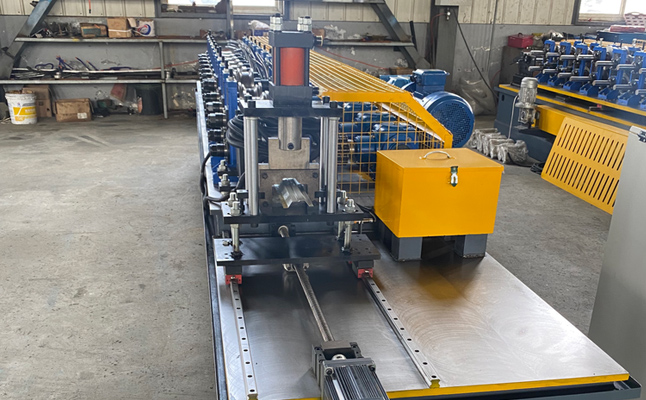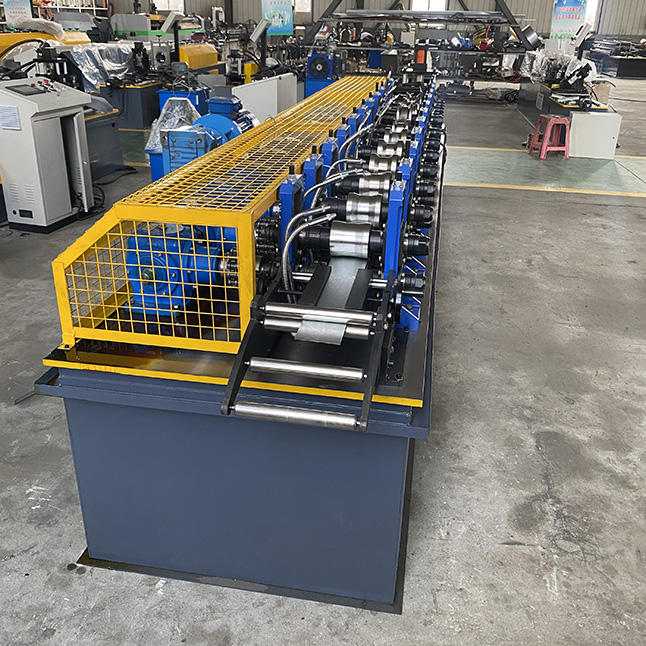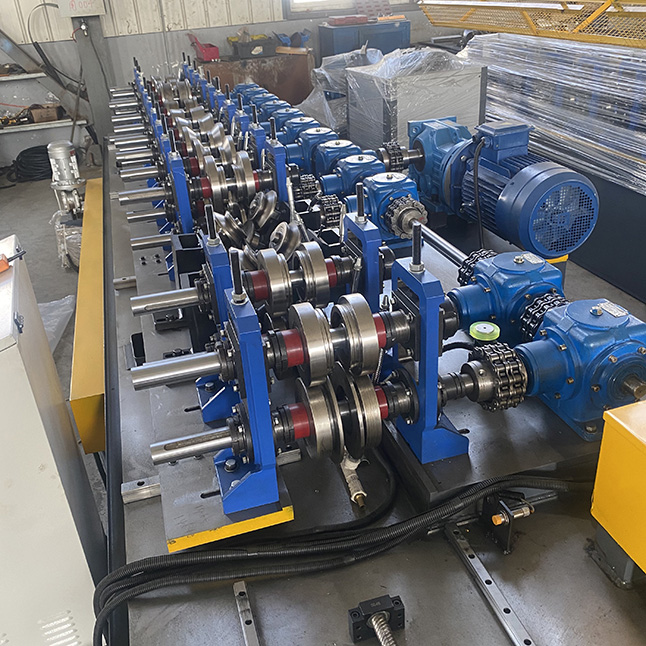
Price:
Detailed Introduction

The hat keel machine is a special equipment for producing hat keels. The hat keel plays an important role in the building ceiling system. It provides support for the ceiling decoration materials and ensures the stability of the overall structure. The following is a detailed introduction to the hat keel machine from the aspects of structural composition, working principle, characteristics, technical parameters and maintenance.
Structural composition
Unwinding device:
It consists of an unwinder and a tension control mechanism. The unwinder is used to carry metal coils, usually steel strips, and unwind the coils by rotating. The tension control mechanism is crucial. It can ensure the stability of the tension of the steel strip during the unwinding process, avoid wrinkles caused by loose steel strips, or stretching deformation of the steel strips caused by excessive tension, so as to ensure the smooth progress of subsequent processing.
Leveling mechanism:
It contains multiple sets of leveling rollers, which are staggered up and down. Its function is to level the unwinding steel strips. Since the steel strips may be uneven during rolling and transportation, such as wavy and curved, the leveling mechanism applies reverse bending force to the steel strips to cause elastic-plastic deformation of the steel strips, eliminate these unevenness, and lay the foundation for subsequent precise forming.
Forming host: This is the core component of the hat keel machine. It consists of a series of carefully designed rollers, which are customized according to the specific shape and size of the hat keel. The motor drives the rollers to rotate through the transmission system. When the steel strip passes through these rollers, it is gradually bent and squeezed into the shape of the hat keel. The precision and quality of the rollers directly determine the forming quality of the hat keel. High-precision rollers can ensure the precise size and regular shape of the keel.
Cutting device: Responsible for cutting the continuously formed hat keel according to the set length. Common cutting methods are hydraulic cutting and mechanical cutting. Hydraulic cutting uses the strong pressure generated by the hydraulic system to drive the cutter. It has the advantages of large cutting force and smooth incision. It is suitable for cutting thicker steel strips; mechanical cutting realizes the action of the cutter through mechanical transmission. The structure is relatively simple and the cost is low. It is often used for cutting small and medium-sized hat keels. The cutting device is usually equipped with a length measuring device to ensure the accuracy of the cutting length.
Control system: Generally, a PLC (programmable logic controller) combined with a touch screen control method is adopted. Operators can intuitively set various production parameters such as unwinding speed, forming speed, cutting length, roller pressure, etc. through the touch screen. The PLC control system can accurately coordinate the actions of various components to realize the automatic operation of the equipment. At the same time, the control system also has fault diagnosis and alarm functions. When the equipment is abnormal, it can quickly display fault information, which is convenient for maintenance personnel to timely troubleshoot and solve problems.
Working principle
The metal coil is placed on the unwinder. As the unwinder rotates, the steel strip is smoothly unwound and enters the leveling mechanism under the action of the tension control mechanism. In the leveling mechanism, the steel strip is reversely bent by multiple sets of leveling rollers and becomes flat. Subsequently, the flat steel strip enters the forming main machine and is gradually formed according to the preset hat keel shape under the gradual action of a series of rollers. When the formed hat keel reaches the set length, the cutting device starts the cutter to cut it according to the signal fed back by the length measuring device. The cut hat keel is collected by the conveying device to complete the entire production process.

Features
Efficient production:
The hat keel machine adopts an automated continuous production method, and each component works together to achieve a fast production speed. The advanced transmission system and efficient control system enable the equipment to respond quickly to operating instructions, achieve high-speed and stable production, greatly improve production efficiency, and meet the large demand for hat keels in the construction industry.
High-precision molding:
With high-precision roller processing technology and precise control system, the hat keel machine can produce products with high dimensional accuracy and good shape consistency. The dimensional deviation of the keel can be controlled within a very small range, ensuring good cooperation during the construction installation process and improving the overall quality and aesthetics of the ceiling system.
Easy operation:
The humanized control system design makes the operation simple and easy to understand. The touch screen operation interface is intuitive and clear, and the parameter setting is convenient. Even operators without rich experience can master the operation method of the equipment after simple training, which reduces the technical threshold of operators.
Product diversification:
By replacing different roller molds, the hat keel machine can produce hat keels of various specifications and shapes to meet different architectural design and construction requirements. Whether it is an ordinary residential, commercial building or industrial plant ceiling project, it can provide suitable keel products.
Good equipment stability:
The overall structure is reasonably designed, made of high-quality steel and components, and the equipment has high strength and rigidity. During long-term continuous production, it can withstand greater working pressure, maintain a stable operating state, reduce the frequency of equipment failures, and improve the reliability and service life of the equipment.
Technical parameters
Processing plate thickness:
Steel strips with a thickness of 0.4-1.2mm can usually be processed. Plates of different thicknesses are suitable for ceiling projects with different load requirements. Thicker plates can be used in large commercial buildings or areas with higher load-bearing capacity requirements, while thinner plates are suitable for general residential ceilings.
Processing plate width:
Common processing plate widths range from 100-200mm. This width range can meet the production needs of most hat keels. By adjusting equipment parameters or replacing some parts, it can also adapt to the production of some special width requirements.
Production speed:
The production speed is generally 8-20 meters/minute. The production speed can be adjusted according to actual production needs and product specifications. Under the premise of ensuring product quality, a higher production speed can be used for simple specifications of hat keels to improve production efficiency.
Cutting length accuracy:
The cutting length accuracy can be controlled within ±1mm. High-precision cutting length ensures the consistency of the length of each cap keel, which is convenient for installation at the construction site and reduces installation problems caused by inconsistent length.
Equipment power:
The total power of the equipment is generally around 7-15kW. The power depends on the specific configuration of the equipment, the production speed and the power requirements of each component. Higher-power equipment is usually suitable for high-speed production or processing of thicker plates.

Maintenance points
Daily cleaning:
After the equipment is finished running, clean up metal chips, oil stains, dust and other impurities on the surface of the equipment in time. Focus on cleaning the unwinding device, leveling mechanism, forming main machine and cutting device to prevent impurities from entering the equipment and affecting the normal operation of the equipment and product quality. Compressed air blowing, wet cloth wiping or special cleaning agent can be used for cleaning.
Lubrication management:
Lubricate the transmission parts of the equipment regularly according to the requirements of the equipment manual. For example, for parts such as chains, gears, bearings, etc., an appropriate amount of lubricating oil or grease is generally added every 8-10 hours of operation. Good lubrication can reduce friction and wear between components, reduce equipment operation noise, and extend the service life of the equipment.
Mold and component inspection:
Check the wear of the roller mold frequently. The roller may have surface wear, scratches or deformation after long-term use, which will affect the molding quality of the cap keel. If the mold is found to be severely worn, it should be repaired or replaced in time. At the same time, check the wear of the cutter of the cutting device, grind or replace the cutter in time to ensure the flatness of the cut surface and the accuracy of the cut length. In addition, check whether the connecting bolts of each component are loose. If they are loose, they should be tightened in time.
Electrical system maintenance:
Check the electrical circuit regularly to see if the wires and cables are aging, damaged, short-circuited, etc. If there are any problems, replace or repair them in time. Check the electrical components of the control system, such as contactors, relays, sensors, etc., to ensure that they have good contact and reliable operation. Clean the dust in the electrical control cabinet to ensure good heat dissipation of the electrical components and prevent electrical failures due to overheating. At the same time, regularly upgrade the software and calibrate the parameters of the control system to ensure the control accuracy and stability of the equipment.
Regular maintenance and debugging:
Perform comprehensive maintenance of the equipment regularly, including inspection and debugging of the overall performance of the equipment. Check the leveling effect of the leveling mechanism, adjust the pressure and spacing of the leveling rollers; check the roller gap and pressure of the forming machine to ensure the quality of keel forming; perform length calibration and cutting force test on the cutting device to ensure cutting accuracy and reliability. Through regular maintenance and debugging, potential problems can be discovered and solved in time to ensure that the equipment is always in good operating condition.
Copyright © Cangzhou Guochen Cold Bending Machinery Equipment Co., Ltd. Rights Reserved Sitemap | Technical Support